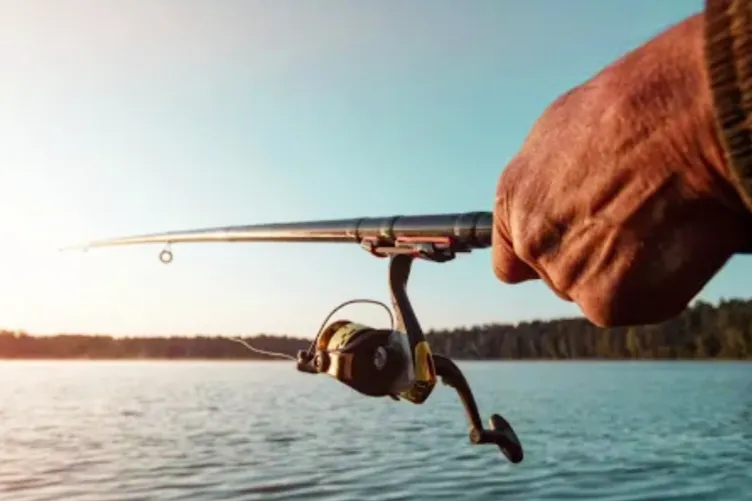
Hey, anglers! Ever been curious about accurately holding your fishing rods? Well, you should. If you are a beginner, I can already tell that you have tons of questions in your mind regarding this. However, your worries are over!
The subject of this article is about holding your fishing rod so that you can maximize your fishing experience to its full potential. Whether you are an expert or a beginner, this article will hopefully help you learn something new. So, don’t just leave in the middle. Have patience and stick through the end.
Why is it necessary to hold a fishing rod properly?
Well, you can hold your fishing rod according to your comfort. We all have different movements and different ways of doing things. However, if you do not properly hold your fishing rod, you will end up putting too much force on your wrists which will result in a tiring experience and the chances of fish stealing your bait would be very high. So, how you are holding your fishing rod matters.
For better accuracy and efficient casting, you have to hold your fishing rod properly.
What are the benefits of holding a fishing rod properly?
Whenever you are doing something the right way, there are always some benefits that you achieve. Similarly, for holding your fishing rods properly, some benefits help you gain a better fishing experience. I have enlisted some of them below to help you get an idea.
1) Accuracy:
Accuracy always depends on the efforts that you are putting into something. This is also applied to your fishing rods. If you have a proper grip on the rod and the hands are well placed, then the accuracy of casting will be very high. This way you will be able to target the specific areas where fish are likely to be and this will increase your chances of catching them successfully.
2) Control:
Another factor that gets improvement is your control. If you have the right grip on your rod, you will have very precise control over not just the fishing line but the bait and lure as well. This better control will allow you to manipulate the movement of your bait much more effectively increasing the chances of catching a fish.
3) Sensitivity:
When you are holding the fishing rod the right way, you can sense things better. This way you will be able to feel what is happening underwater. You will be able to feel the movements and fish bites very clearly because of your focus. This will allow you to detect fish showing interest in your bait and the chances of the fish stealing your bait will be very low.
4) No Fatigue:
This is among the common issues that people face and complain about. It is because you have not positioned your hand accurately. When you have proper hand positioning, the grip will distribute the pressure evenly and this will reduce the strain on your hands and wrists. So, you will be able to prevent fatigue which will allow you to fish comfortably for very long periods.
5) Better Casting:
As mentioned above, having a better grip on your fishing rod makes you very efficient. This helps you in implementing the casting techniques in a better way and you can improve your casting. This makes you generate more power, letting you achieve greater distances which increases your chances of finding a fish. The more area you will be able to cover efficiently, the more quickly you will be able to catch.
6) Hook setting:
When your grip is just right, you can easily set the hook firmly when a fish bites. This is a very crucial point because it ensures that the connection between your fishing line and the fish is very secure. This effectively reduces your chances of losing the fish making you a better angler.
7) Tangling:
You might be wondering what tangling has to do with holding. However, it is related to it. If you have a proper grip on your fishing rod such as with baitcasting reels, you can prevent the tangles and backlashes. This helps you control the speed of the spool while casting and reduces the risks of frustrating line snarls.
8) Safety:
Safety is very important when it comes to fishing as it can cause you injury. If you have a good grip on your fishing rod, you will minimize the risk of accidents. This way you won’t be able to hurt anyone and won’t be able to injure yourself for losing control.
9) Adaptability:
We know that there are different types of fishing rods. They all come with different perks and features. This tells that they all have different techniques for holding them right. So, if you have learned how to hold one kind properly, you will be able to adapt it to other rods, and holding different fishing rods will be easier for you.
10) Consistency:
When you have a consistent grip on your fishing rod, your fishing actions such as casting, reeling, and setting the hook are consistently effective. This consistency is needed because it helps you to have more predictable and more successful results while fishing.
11) Enjoyment:
We know that fishing is all about enjoying yourself. When you know that you are holding a rod properly, it contributes to a more enjoyable and fulfilling fishing experience. This is because you have control, accuracy, and sensitivity that make the act of fishing rewarding for you.
Which hand you should use to hold a fishing rod, left or right?
Holding a fishing rod depends on the level of your comfort. You can hold it keeping in mind your ease. However, typically you have to hold it with your dominant hand. It doesn’t matter if you are holding the fishing rod with your left or right hand. You just have to know your dominant hand and hold the rod with it. This helps you to have better control of your fishing rod leading to a better fishing experience.
Why you should cast with your dominant hand?
Holding the fishing rod with your dominant hand is important if you want to save time and have better control over your fishing rod. Your dominant hand is stronger for holding the fishing rod. This helps you fight the fish while catching it. Your non-dominant hand is used on the reel. It usually supports and stabilizes the fishing rod.
How to hold a fishing rod properly?
Now that you are aware of the need to hold a fishing rod correctly, this part of the article is about how to hold it. I have divided it into several portions for your better understanding. Let us start with the parts of a fishing rod.
Which parts of the fishing rod do you have to interact with while holding?
When holding a fishing rod, you have to interact with some of its parts. For better learning, you should know the basics about those parts of your fishing rod.
1) Handle or Grip:
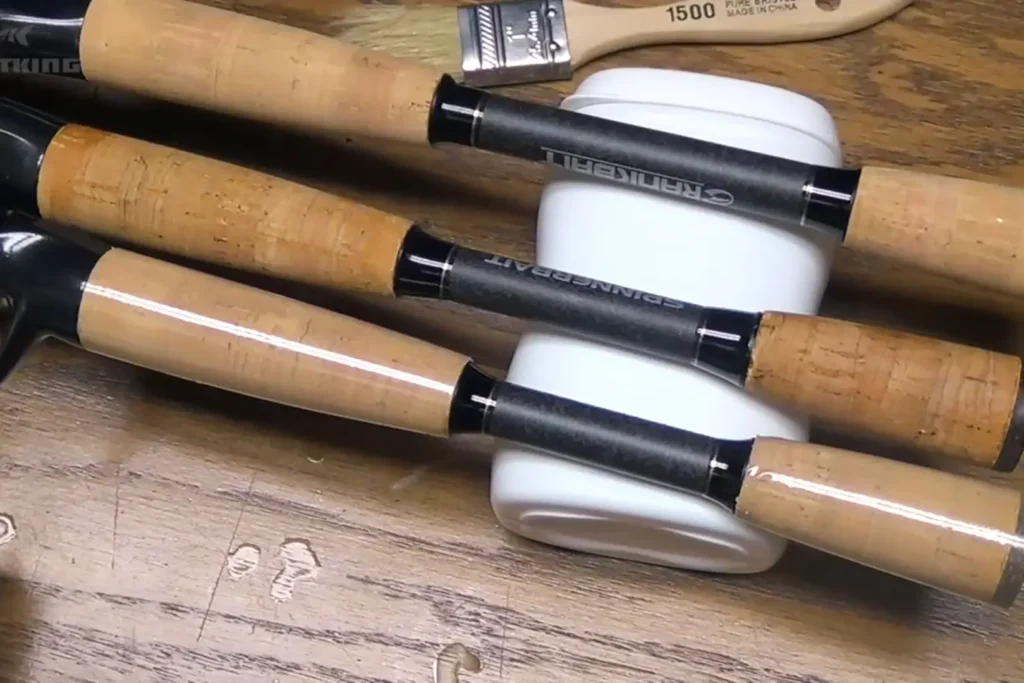
This is the part of the fishing rod that your hand mostly interacts with. There are different styles and shapes of grips depending on the type of fishing rod and your personal preferences. You have to hold the handle with your dominant hand for better results.
The grip of your fishing rod can be divided into three further parts.
A) Foregrip: This part of the grip is closest to the reel seat. This is the area where you have to put your dominant hand to hold a fishing rod.
B) Rear grip: This portion is farthest from the real seat and is closest to the rod blank. With this part, your non-dominant hand often supports the rod.
C) Butt cap: This part is known as the end of the handle and usually has a cap or knob. This part is useful in providing stability and balance when the fishing rod is being pressed against your body.
2) Reel seat:
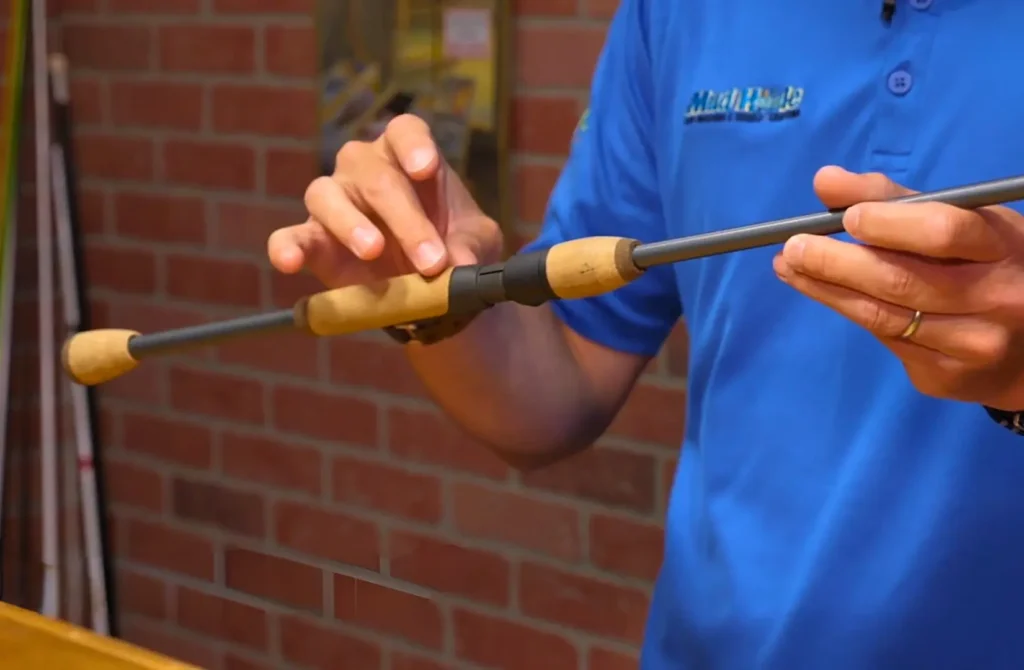
This is another part of your fishing rod where your hands have to interact. This is the part where the fishing reel is securely attached to your fishing rod. This has, usually, locking mechanisms involved that keep the reel in place.
3) Rod blank:
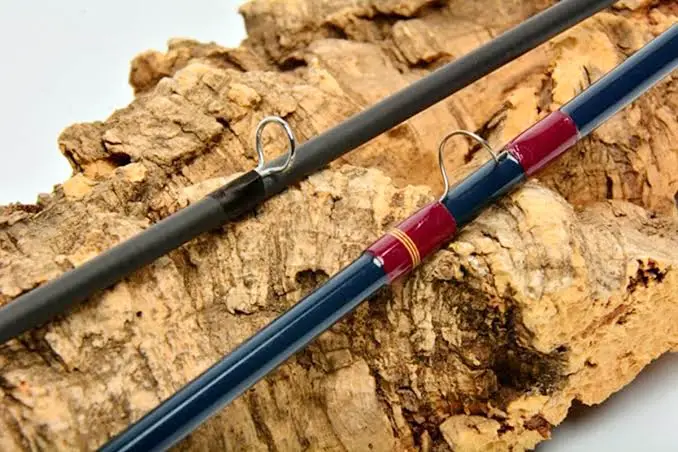
Rod blank is the straight sleek rod-like part of your fishing rod that guides the fishing line. The rod blank is called the main shaft or body of the fishing rod. Its length extends from the handle to the tip. Why is it important? It is important because it not only holds the guides but is responsible for providing the backbone feature and flexibility.
4) Guides:
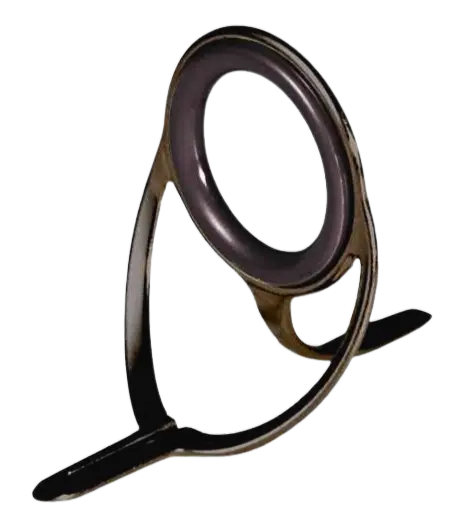
These are circular-shaped eye-like oval rings that are typically attached along the length of the fishing rod. They are used for guiding the fishing line from the reel toward the tip of the fishing rod during casting and retrieval. You may not have to touch them at all but they keep your fishing line in a straight path and protect the line from breaking and tangling.
5) Tip:
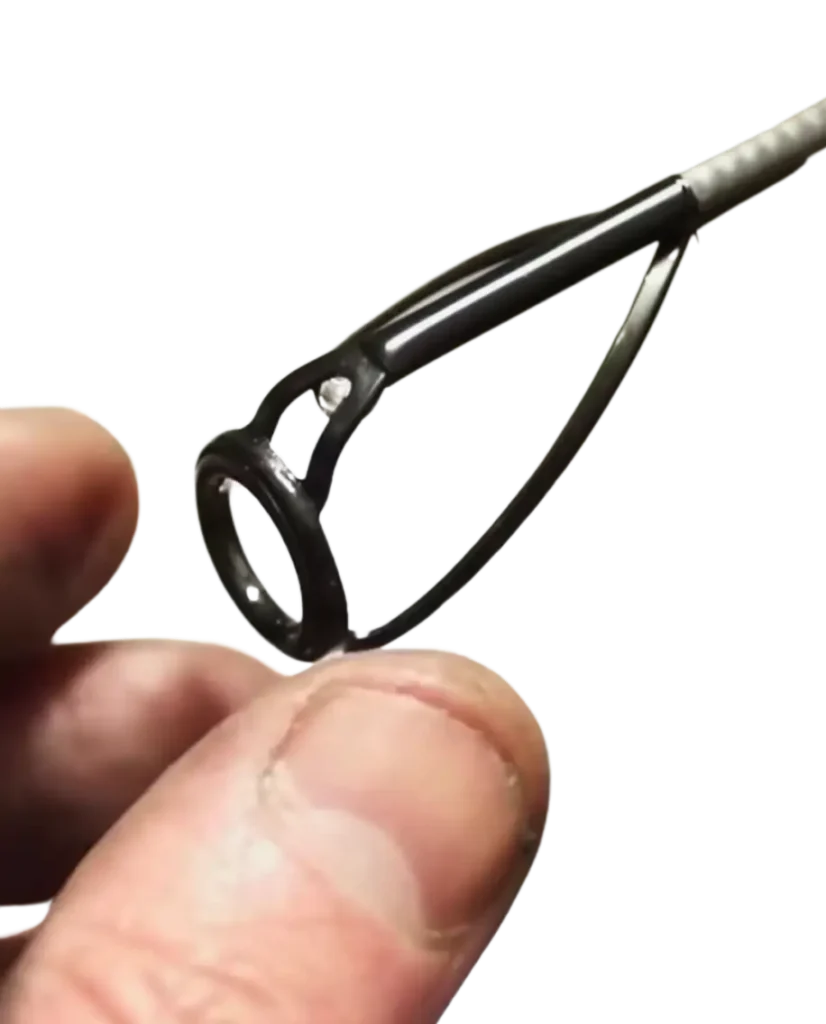
The tip is the top most and the last part along the length of the fishing rod. It is built with a lot of flexibility. It not only keeps the fishing line on a straight path but also helps in detecting the fish’s movement. You might be wondering how? The tip is very flexible and is a lot sensitive. It helps us detect even the minor vibrations caused because of fish movement. Which tells us that the fish is messing up with the bait.
If you want to learn more about the parts of a fishing rod, read “fishing rod parts“.
Seven steps to hold the fishing rod right-handed
When it comes to holding a fishing rod with the right hand, you have to focus on hand placement and some techniques. As most people have their right-hand dominant, I will be giving you step-by-step instructions for the right hand.
Step#1 Comfortable stance:
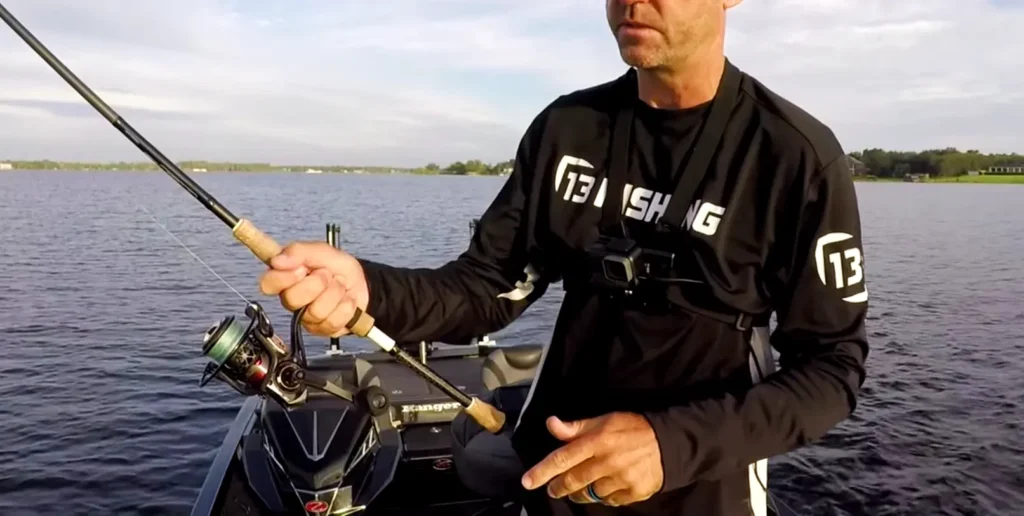
The first thing that you have to be sure about is your stance. The way you stand matters a lot. Some people are not balanced enough and when they sense fish movement, they end up being startled and hurting themselves. To avoid this, you have to be standing with your feet shoulder-width apart. You should be facing the direction where you are aiming to cast. Make sure that you are comfortable and stable.
Step#2 Dominant hand:
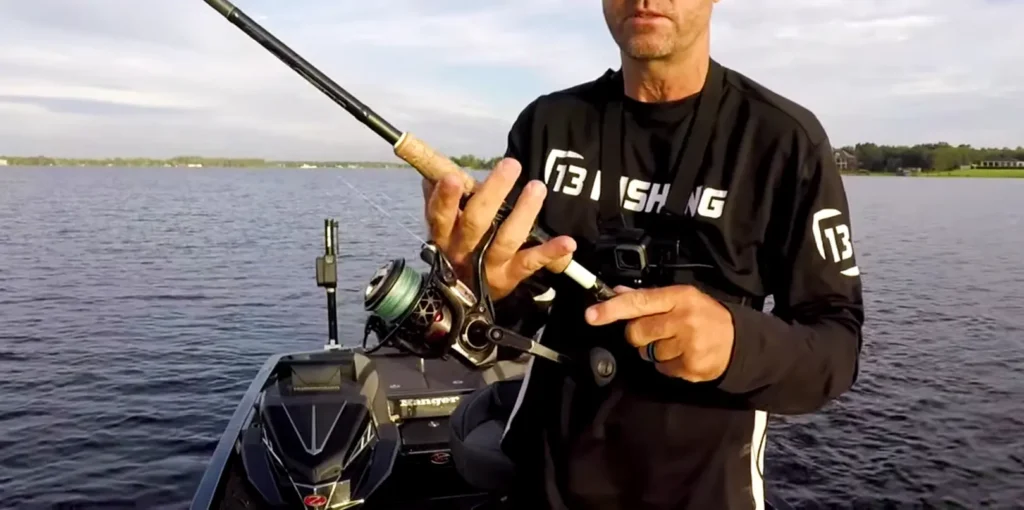
Now that you are standing in the correct position, you have to determine your dominant hand. In fishing, your dominant hand is the hand that you will use for gripping and controlling the fishing rod handle. As this guide is for the right hand, you have to use your right to grip. If you are left-handed, then you will be using your left hand for grip. The process is not very complicated. You just have to be stable.
Step#3 Gripping the handle:

Now you have to grip the rod handle. Using your dominant, you will have to grasp the fishing rod handle securely. It should be a good grip but do not hold it too tightly. You have to make your fingers naturally encircle the rod handle which will give you a comfortable and firm grip. If you are holding too tight, you might end up getting fatigued soon so do not do that. You can keep practicing with your grip to be better at it.
Step#4 Finger placement:
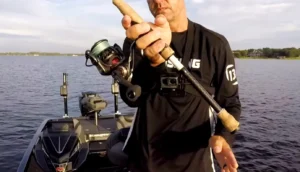
When it comes to placing your fingers, your index is very important. You have to extend your index finger along the top of the rod handle. This finger will not only just provide you good control over your rod but will also help you in sensing the movements.
The next thing is your thumb. For additional control, you have to rest your thumb lightly on the underside of the handle.
Step#5 Your non-dominant hand:
You might be wondering what is the use of your spare hand, well here is your answer. Your non-dominant hand is used to support and stabilize the fishing rod. You have to position it above the reel seat which is the section where the reel attaches to the rod.
With this hand, you should lightly grip the rod blank or the section above the reel seat. The primary role of this hand is to provide you with stability.
Step#6 Reel handle management:
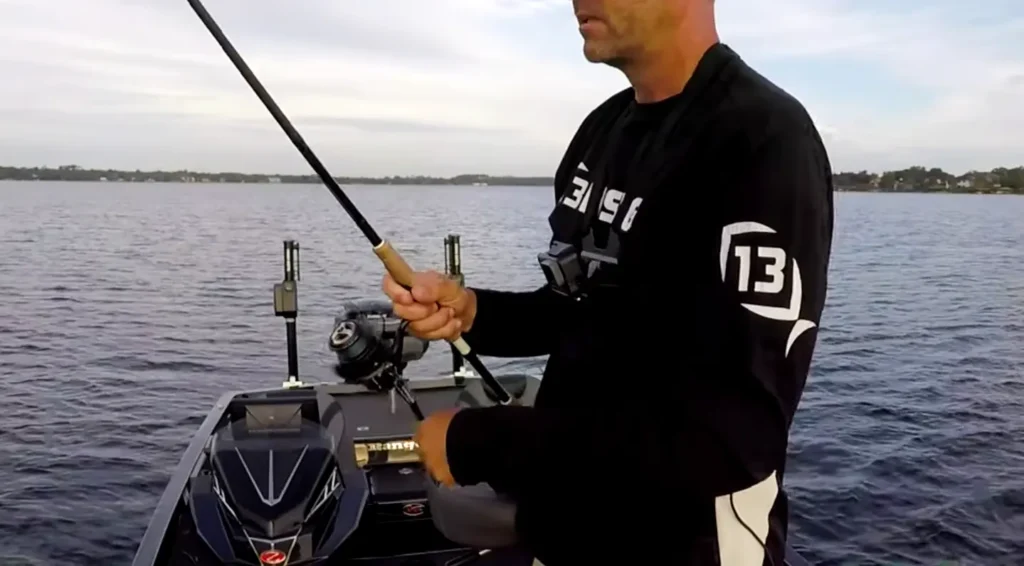
This depends on the type of fishing rod you have. If you have a spinning reel, the reel handle will be on the opposite side of your dominant hand. For this, you will have to use your non-dominant hand to turn the reel handle when you are reeling in the line or working your bait or lure.
To generate the casting motion, you will have to engage your dominant hand and wrist. Then release the fishing line by flipping the bail open with your non-dominant hand while holding the lightly with your index finger. Again, here your index comes into play. During the cast, your non-dominant hand will be guiding and controlling the rod movement.
Step#7 Sensitivity and control:
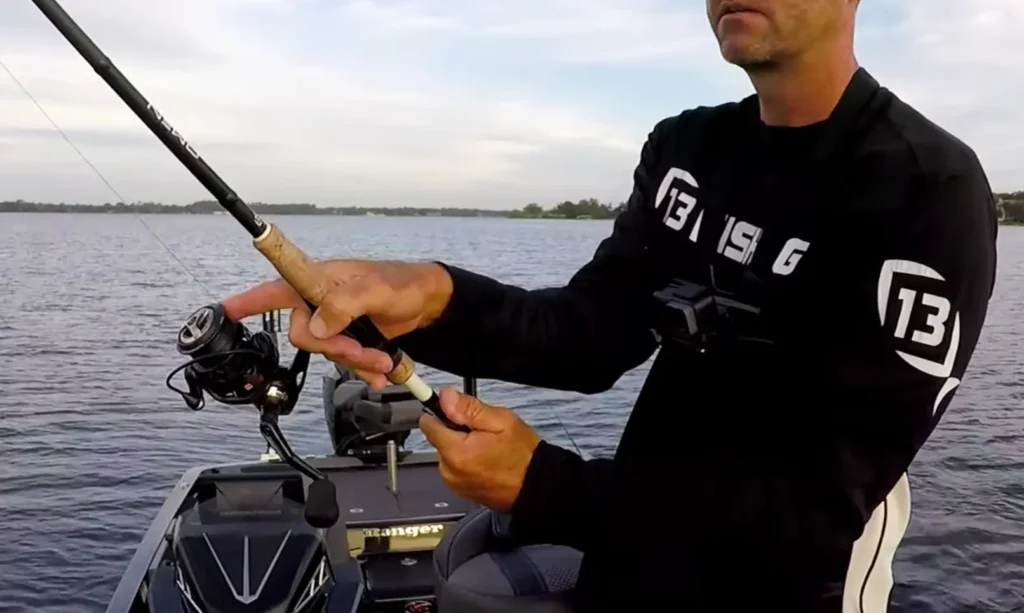
You have to focus on maintaining sensitivity to feel fish bites or any changes in tension transmitted through the rod line. When you feel that there is a fish bite, use your dominant hand to set the hook swiftly and firmly, and then continue to reel in the fish. Hopefully, you will be able to catch your fish.
How to hold a fishing rod left-handed?
How to hold a fishing rod has always been a personal preference. However, if you are left-handed, you will have to use your left hand for casting and your right hand for spinning the reel. You just have to keep in mind that your dominant hand will be the one to cast.
What is the best angle for fishing?
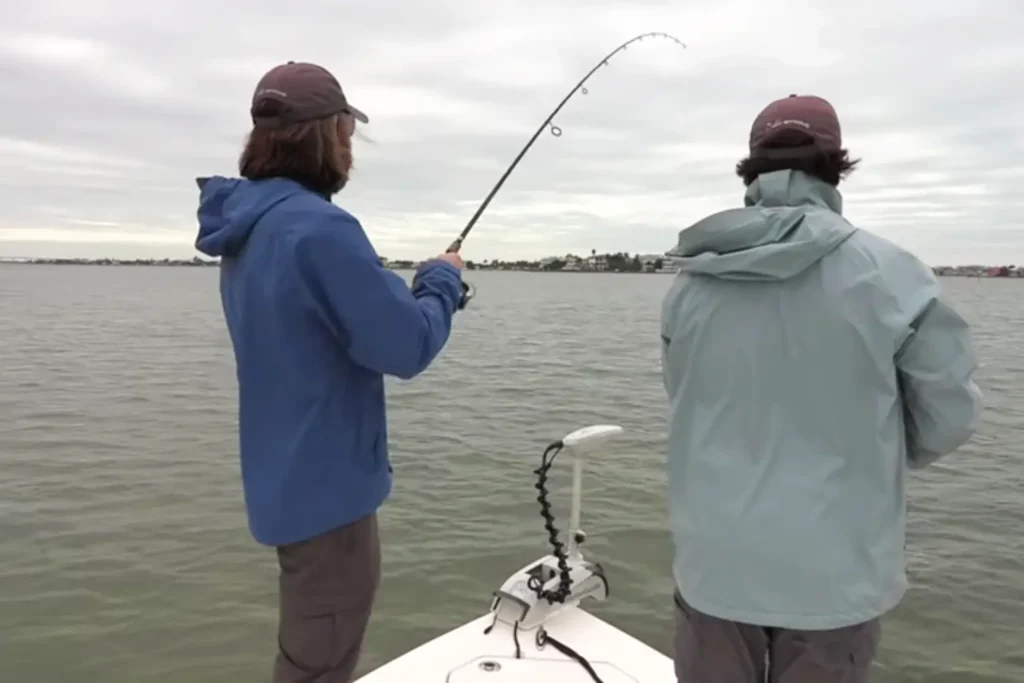
Holding a fishing rod depends on your level of comfortability. However, for a better fishing expedition, you should lower the rod tip and bring the butt section down from 90 degrees to 45 degrees. This way you will be able to pull up the fish using the strongest part of your fishing rod and the chances of your success would be high.
How to hold a spinning rod?
Spinning rods are known for their ease of use and are suitable for beginners. You open the bail with your non-dominant hand and cast with your dominant hand. Below are a few steps to show you how to hold a spinning rod.
Step#1
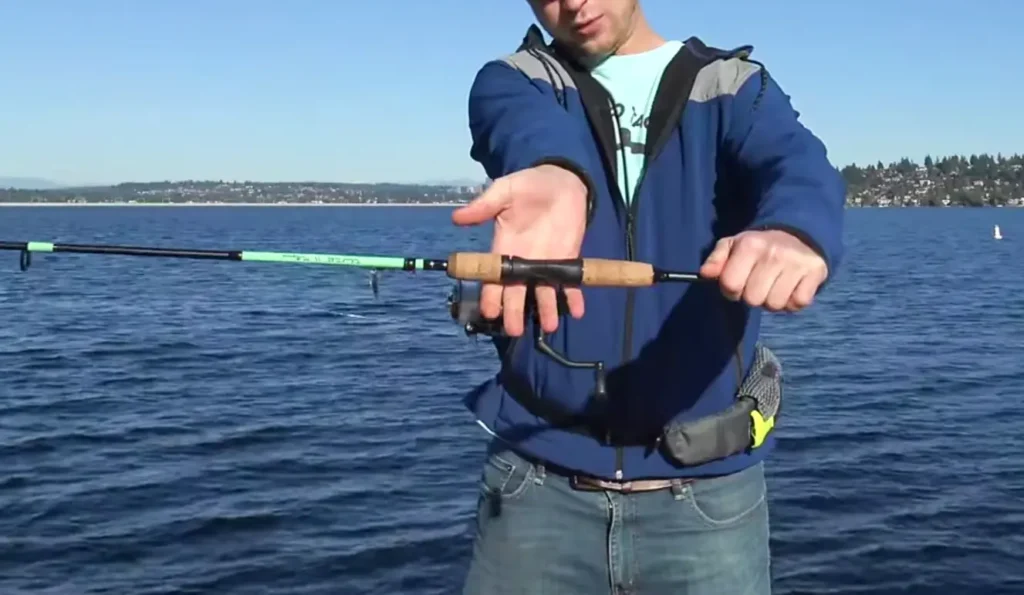
You have to determine which hand is dominant. Your dominant hand will be used to hold the spinning rod handle. The choice depends on your personal preference. However, right-handed people will be holding the rod handle with their right hands, and left-handed will be holding it with their left.
Step#2
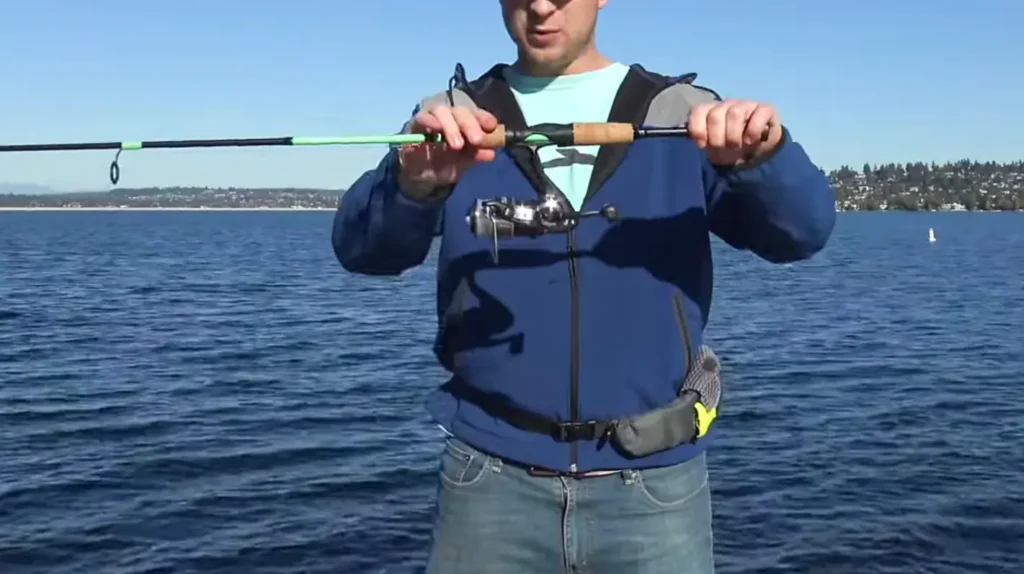
This step is about having a grip on the rod handle. Use your dominant hand and grasp the spinning rod handle securely but not too tightly. Create a comfortable grip by encircling your fingers around the handle naturally. Your thumb should be resting on top of the handle whereas your index should extend along the top of the handle. These fingers are very much responsible for control and sensitivity for the casting and line management.
Step#3
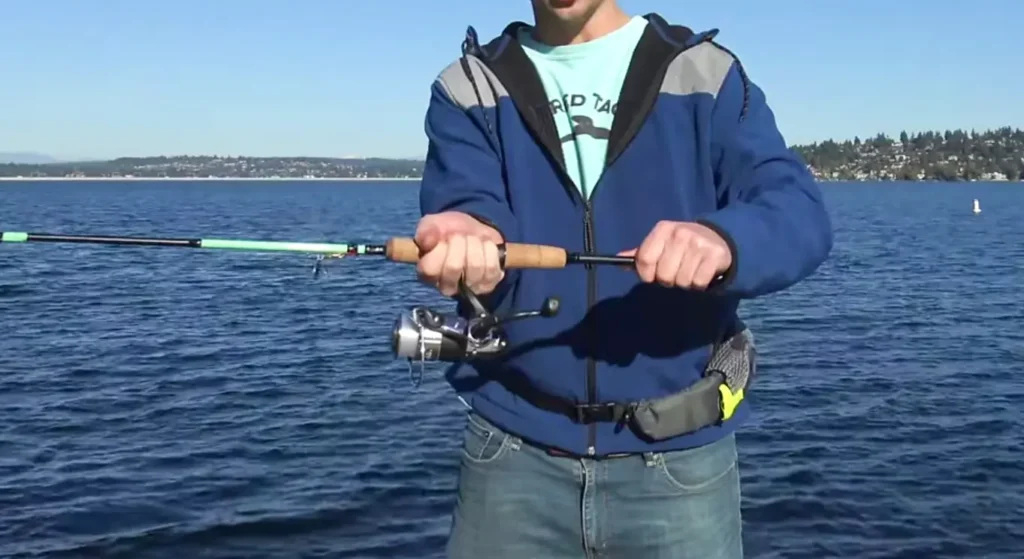
Now you have to create a support with your non-dominant hand. You have to stabilize the spinning rod and position your hand above the reel seat. Your non-dominant hand should lightly grip the rod blank. The major role of this hand is to provide you with additional control and stability while fishing.
Step#4
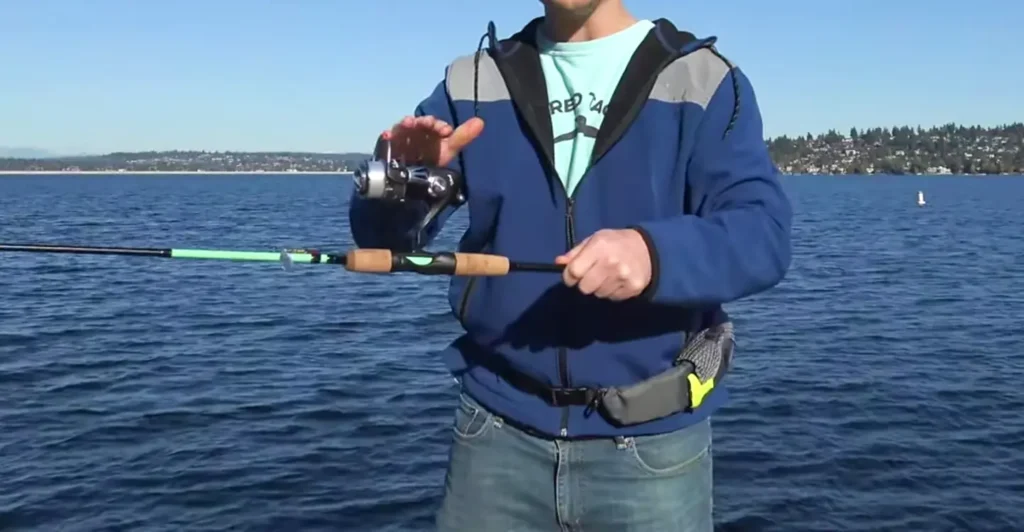
The last stage is about reel handle management. The reel of a spinning rod is mounted underneath the rod. You have to use your non-dominant hand to operate the spinning reel’s handle. Throughout your fishing, this hand will be responsible for reeling in the line and managing the bail. When you are about to cast, open the bail with this hand and hold the line lightly with your index finger. Then use your dominant hand to control the rod’s movement and guide the line’s release.
What side should your reel be on?
This is a matter of personal preference and depends on your dominant hand. If you are a right-handed angler, choose a fishing rod with a crank handle on the left side. Similarly left-handed anglers should use a fishing rod with a crank handle on the right. For your convenience, the manufacturers often label them as right-handed or left-handed.
Can you change the position of your fishing reel?
Changing the position of the fishing reel depends on the type of fishing rod. Baitcasting rods are either right-hand or left-hand specific. However, you can change the position of your reel from left to right or right to left in spinning rods. They are flexible and beginner-friendly.
How to change the position of your fishing reel?
You can change the position of your fishing reel by unscrewing the knob that is on the opposite side of the handle. For this, you have to locate the reel handle and check it for reversibility. If it is reversible then use a screwdriver to loosen and remove the screw or fastener. Once the handle is removed, you simply have to attach it to the opposite side of the reel. Just make sure that it is securely fastened.
What are the mistakes that people make while holding a fishing rod?
There are some common mistakes that anglers do unintentionally which reduce the performance of their fishing rods. I have enlisted some of them below. So, make sure that you avoid them at all costs.
1) Tight Grip:
I have mentioned this point above and I will repeat it gripping your fishing rod too tightly will do you no favor. This will reduce the sensitivity and will make it hard for you to detect fish bites. For effective fishing, a firm but relaxed grip is always recommended.
2) Incorrect hand placement:
Just the way your grip is important, your hand placement plays a great role too in fishing. Incorrect hand placement especially on the rod handle can affect the casting accuracy and control. So, make sure that your hands are positioned correctly according to the reel type that you are using.
3) High sticking:
Some anglers have this habit of raising the fishing rod tip too high. They often do it during a fight with a fish. It might seem harmless but it can lead to rod breakage, especially if you are meddling with a big fish. So, make sure that your fishing rod is at a moderate angle and avoid excessive bending.
4) Overloading:
Too much pressure and weight can destroy anything. The same is applied to fishing rods. If you are applying excessive force while realizing that the fish can overload the capacity of your fishing rod, you can cause it to break. Always match your rod’s power and action with the fish species that you are targeting.
5)Neglecting Non-dominant hand:
We know that your dominant hand is mainly responsible for holding the fishing rod. However, your non-dominant is equally important. If you neglect the use of your non-dominant hand for supporting and stabilizing the fishing rod, it can result in poor control and balance. Both of your hands should work together for effective rod management.
6) Wrong thumb position:
This point is very important if you have a spinning reel. You have to make sure that your thumb is in the right position. Even if you forget to use your index finger to lightly touch the fishing line, on a spinning reel, this can easily lead to line tangles.
7) Wrong thumb control:
If you have a bait caster reel, you have to use your thumb during casting. If during cast, you are not using your thumb to control the spool, then it can result in backlashes. This can easily cause line tangling so avoid it at all cost for a better fishing expedition.
8) Poor casting:
Improper casting techniques are also a common issue among anglers. They sometimes fail to use proper casting techniques such as using their body to generate casting power or applying the correct amount of force. These mistakes can easily reduce the casting distance which leads towards less accuracy.
9) Poor reel maintenance:
For good fishing experiences, you regularly have to maintain your fishing reel so that it is not corroding. Your neglect to clean and maintain your fishing reel can lead to low performance. This can even cause reel malfunctions that affect the overall fishing expedition.
10) Hook sets:
Setting the hook with enough force is also very important. If you are not using suitable force for hook setting, then during fish bites the chances of missed opportunities and lost fish are very high.
11) Poor reeling:
Having a good grip on how to reel properly is very important. You should be very smooth and steady with it. If your reeling technique is poor and is not proper enough, this leads to line twists, tangles, and even lost fish. And I’m sure that you do not want this.
12) Incorrect rod storage:
Proper fishing rod storage is very important. You should not just lean your fishing rod against a wall or just place heavy objects on top of it. This can easily cause damage and deformation as they are brittle.
To learn more about fishing rod storage, read “Fishing rod storage ideas”.
13) Wrong combination:
As an angler, you should know about rod and line combinations. If your rod is mismatching with the line weight ratings, this can result in poor casting performance and can cause difficulty in line control and lure control.
How do you hold a line when casting?
When casting, you have to use your index finger. Lightly pinch the line against the rod so that you can maintain tension during the cast. Then release the line at the desired moment. During this, avoid gripping it too tightly to prevent any backlashes, and keep your finger away from the line guide.
Final words
Finally, I will say that choose your grip according to your comfort. Do follow the guidelines but at the same time make sure that they suit you. For this, keep practicing to improve your rod grip skills. Your practice will help you a lot and will make your fishing expeditions more enjoyable.
